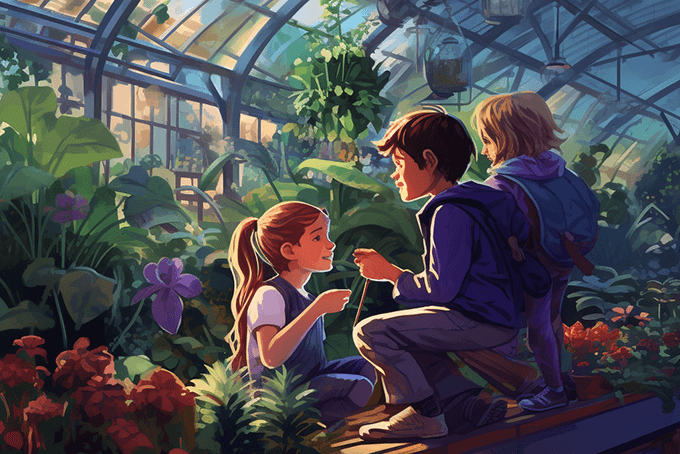Central Park, located in the heart of New York City, is not only a magnificent urban oasis but also a hub of scientific exploration for kids. With its diverse ecosystems, fascinating geological formations, and educational institutions, Central Park offers a myriad of fun and educational science activities that will captivate young minds. Whether your child is interested in nature, astronomy, or wildlife, there is something for everyone. Let’s dive into the wonders of Central Park and the list of things to do in New York with kids!
Exploring the Wonders of Central Park
The History of Central Park
Before we embark on our scientific journey in Central Park, let’s take a moment to appreciate the park’s rich history. Designed by Frederick Law Olmsted and Calvert Vaux in the mid-19th century, Central Park was created to provide a respite from the bustling urban environment. It’s amazing to think that what was once a rocky and swampy area has been transformed into an iconic urban green space that spans 843 acres!
Central Park’s history is filled with fascinating stories and anecdotes. Did you know that during the Great Depression, the park became a source of employment for thousands of workers? The construction of various features, such as the iconic Bethesda Terrace and Fountain, provided much-needed jobs and helped revive the city’s economy. It’s a testament to the park’s enduring legacy and its ability to bring people together even during challenging times.
Unique Features of Central Park
Central Park boasts a multitude of unique features that set it apart from other urban parks. From the picturesque Jacqueline Kennedy Onassis Reservoir to the iconic Bow Bridge, every corner of Central Park offers a sense of wonder and discovery. As we explore the park, keep an eye out for famous landmarks like Belvedere Castle, the Alice in Wonderland statue, and the Bethesda Terrace and Fountain, which have become beloved symbols of Central Park’s charm.
One of the lesser-known features of Central Park is the Hallett Nature Sanctuary, a hidden gem nestled in the heart of the park. This peaceful oasis provides a habitat for various species of birds, butterflies, and other wildlife. It’s a perfect spot for nature enthusiasts to observe and appreciate the park’s biodiversity. The sanctuary offers a stark contrast to the bustling cityscape just beyond its borders, reminding us of the importance of preserving and protecting our natural environments.
Science Activities for Kids in Central Park
Nature Walks and Wildlife Spotting
One of the most exciting aspects of Central Park is its abundant wildlife. Grab a pair of binoculars and embark on a nature walk with your child. The park is home to numerous bird species, including migratory birds during certain seasons. Encourage your child to observe and identify different bird species using field guides or birding apps. Don’t forget to pack a notebook for them to record their findings and create their own nature journal!
Aside from birds, you may also encounter squirrels, chipmunks, turtles, and even raccoons during your exploration. Teach your child about the importance of respecting wildlife from a safe distance and remind them not to feed or approach any animals they encounter.
As you wander through the park, take a moment to appreciate the intricate web of life that exists within this urban oasis. Discuss the interconnectedness of different species and how they rely on each other for survival. Point out the role of insects in pollination and the importance of plants in providing food and shelter for animals. By exploring Central Park’s wildlife, your child will gain a deeper understanding of the delicate balance of nature.
Geological Wonders in Central Park
Central Park is not only a marvel of nature but also a geological wonder. Take a stroll along the park’s pathways and keep an eye out for unique rock formations. From the rocky outcrops of Rat Rock to the iconic Hallett Nature Sanctuary, there are ample opportunities to learn about geology and the park’s fascinating rock formations.
To further enhance your child’s understanding, consider bringing along a small geology hammer and safety goggles. Explore the different types of rocks you encounter, observing their textures and colors. You may even stumble upon quartz, shale, or granite. Encourage your child to collect small rock samples (with permission and within park regulations) for a hands-on learning experience.
As you examine the rocks, discuss the forces of nature that shaped them over millions of years. Talk about the power of erosion, the movement of tectonic plates, and the formation of mountains. By exploring Central Park’s geological wonders, your child will develop a newfound appreciation for the Earth’s geological history and the processes that have shaped our planet.
Astronomy Nights in Central Park
What better way to spark your child’s curiosity about the universe than stargazing in Central Park? The Amateur Astronomers Association of New York organizes regular stargazing events in the park, allowing children and adults alike to marvel at the wonders of the night sky. Telescopes are usually available for public use, and astronomy enthusiasts are always ready to share their knowledge and answer questions.
Prioritize attending any scheduled meteor showers or celestial events, but even on a regular night, the expansive open skies of Central Park will provide a captivating experience. Come prepared with a star map or a stargazing app to help your child identify constellations, planets, and other celestial bodies. Don’t forget to bundle up and bring a cozy blanket for a truly magical experience!
During your stargazing adventure, take the opportunity to discuss the vastness of the universe and the concept of light years. Talk about the different types of stars, galaxies, and nebulae that exist beyond our planet. Encourage your child to ponder the possibility of extraterrestrial life and the mysteries that still await discovery in the depths of space. By exploring the night sky in Central Park, your child will develop a sense of wonder and awe for the vastness of the cosmos.
Educational Institutions Offering Science Activities
Central Park Zoo’s Educational Programs
The Central Park Zoo, located within the park’s boundaries, offers a range of educational programs focused on conservation and wildlife. From interactive presentations to behind-the-scenes tours, the zoo provides an immersive learning experience for children of all ages. Your child can learn about endangered species, animal behaviors, and the importance of conservation efforts. Check the zoo’s website for the full schedule of programs available during your visit.
American Museum of Natural History’s Outdoor Activities
Located just a stone’s throw away from Central Park, the American Museum of Natural History offers outdoor programs that take full advantage of the park’s natural surroundings. These programs cater to different age groups, covering topics such as paleontology, botany, and ecology. Your child can participate in interactive workshops, guided nature walks, and even fossil hunts! Be sure to check the museum’s website for the latest schedule of outdoor activities.
The New York Botanical Garden’s Children’s Programs
While not directly within Central Park, the New York Botanical Garden is a short distance away and offers an array of immersive educational experiences for children. From nature-themed scavenger hunts to hands-on gardening workshops, the botanical garden provides the perfect setting for your child to explore the wonders of plants and the environment. They will develop an appreciation for the natural world while engaging in fun and educational activities.
As you explore the Central Park Zoo’s educational programs, you’ll be delighted to know that they have a dedicated team of educators who are passionate about wildlife conservation. These experts are not only knowledgeable but also skilled at engaging children in meaningful and interactive learning experiences. Through their guidance, your child will gain a deeper understanding of the delicate balance of ecosystems and the importance of protecting our planet’s biodiversity.
At the American Museum of Natural History, the outdoor activities are carefully designed to spark curiosity and foster a love for science in children. Imagine your child embarking on a guided nature walk, discovering the hidden treasures of Central Park, and learning about the different plant and animal species that call it home. They might even stumble upon a fossil during a thrilling fossil hunt, igniting their passion for paleontology and the mysteries of the past.
Seasonal Science Activities in Central Park
Spring and Summer Activities
As spring brings new life to Central Park, take advantage of the blooming flowers and fresh foliage. Engage your child in a scavenger hunt to identify different types of flowers and trees. Encourage them to sketch or take photographs of their findings. This activity will not only teach them about floral diversity but also ignite their creativity.
During the summer, the park comes alive with buzzing insects and vibrant butterflies. Bring a magnifying glass to get a closer look at these fascinating creatures. Explore the Conservatory Water area and challenge your child to identify different insect species. You can also create a butterfly-friendly garden in your backyard by growing nectar-rich flowers and providing a water source.
Fall and Winter Activities
As the leaves change colors in the fall, organize a leaf-collecting adventure with your child. Encourage them to collect different types of leaves and create leaf rubbings or artistic collages. Take the opportunity to teach them about the science behind this seasonal transformation, explaining the role of chlorophyll and pigments in leaf coloration.
Winter in Central Park offers unique experiences. If there’s snow, engage in some snowflake observation. Show your child how to catch snowflakes on a dark piece of fabric and examine them with a magnifying glass. Discuss the intricate patterns and teach them about the molecular structure of water. Even when there’s no snow, the bare branches of trees reveal their unique forms, providing an opportunity to study tree morphology.
Preparing for Your Science Adventure in Central Park
What to Bring for Your Science Exploration
Before heading out for your science adventure in Central Park, make sure you pack a few essentials:
- Sunscreen: Protect your child’s skin from harmful UV rays, especially during the warmer months.
- Water and Snacks: Stay hydrated and energized during your exploration. Pack healthy snacks like granola bars or fruit.
- Field Guides and Apps: Enhance your child’s learning experience with field guides or mobile apps for bird identification, plant identification, and stargazing.
- Camera or Smartphone: Encourage your child to capture their scientific findings or anything that sparks their curiosity.
Safety Tips for Things to do in New York with Kids
While exploring Central Park, safety should always be a top priority:
- Stay on Marked Paths: Stick to designated trails and pathways to avoid damaging wildlife habitats.
- Dress Appropriately: Wear comfortable clothes and appropriate footwear for walking, hiking, and outdoor activities.
- Stay Hydrated: Drink plenty of water during your exploration to prevent dehydration.
- Check for Ticks: Lyme disease-carrying ticks can be present in wooded areas. After your adventure, perform a tick check and promptly remove any ticks if found.
Making the Most of Your Science Adventure
Finally, remember that the goal of your science adventure is not just to gather knowledge but also to ignite a lifelong love for science and inspire curiosity. Encourage your child to ask questions, make observations, and draw connections between what they learn in school and what they experience in nature. Fuel their passion by nurturing their interests, providing opportunities for further exploration, and celebrating their scientific inquiries!
So, next time you’re looking for fun and educational things to do in New York with kids, head over to Central Park and let the wonders of science unfold before their eyes. The park’s abundant natural beauty, combined with engaging educational programs, will undoubtedly leave a lasting impression on their young minds. Happy exploring!



